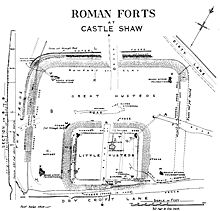Castleshaw Roman Fort
| Castleshaw Roman fort | |
|---|---|
 A ditch of Castleshaw Roman fort | |
| General information | |
| Architectural style | Roman fort |
| Town or city | Castleshaw Saddleworth Greater Manchester |
| Country | England |
| Coordinates | 53°34′59″N 2°00′11″W / 53.583°N 2.003°W |
| Completed | 79 |
Castleshaw Roman fort was a castellum in the Roman province of Britannia. Although there is no evidence to substantiate the claim, it has been suggested that Castleshaw Roman fort is the site of Rigodunum, a Brigantian settlement. The remains of the fort are located on Castle Hill on the eastern side of Castleshaw Valley at the foot of Standedge but overlooking the valley.[1] The hill is on the edge of Castleshaw in Greater Manchester. The fort was constructed in c. AD 79, but fell out of use at some time during the 90s. It was replaced by a smaller fortlet, built in c. 105, around which a civilian settlement grew. It may have served as a logistical and administrative centre, although it was abandoned in the 120s.
The site has been the subject of
Location

The fort and fortlet at Castleshaw are situated on a step of
History
Roman
The fort at Castleshaw, constructed from turf and timber, was built around AD 79 and guarded the
The fort was replaced by a fortlet, also built using turf and timber, in AD 105. Although the fortlet was built on the same site as the fort, it did not use the same foundation trenches.
According to
Post-Roman

After being abandoned by the Romans, Castleshaw was rediscovered by antiquarian
Under the supervision of the
Layout

The fort was rectangular in shape and had sides of 115 metres (377 ft) and 100 metres (330 ft), covering an area of approximately 1.2 hectares (3.0 acres).[1][2] The fortlet was built over the south of the fort, making it difficult to discover what lay beneath.[19] It has been possible, however, to ascertain that barrack buildings lay on the east side of the fort, a granary on the north, and the principia and praetorium to the south west.[7][23]
The fortlet was rectangular, with sides of 50 metres (160 ft) by 40 metres (130 ft), and covered 1,950 square metres (0.48 acres).[1][2] It was originally thought to be surrounded by a single Punic ditch but investigation revealed there to be two Punic ditches separated by a 2 metres (6.6 ft) wide berm.[24] The inner ditch was 3.9 metres (13 ft) wide and 1.3 metres (4.3 ft) deep while the outer ditch was 2.5 metres (8.2 ft) wide and 0.9 metres (3.0 ft) deep.[25] A Punic ditch is a defensive v-shaped ditch with one side much steeper than the other; the ditches surrounding the fortlet had an outer face at 27 degrees and the inner face at 69 degrees.[25] The rampart behind the ditches only survives to 0.5 metres (1.6 ft) at its highest point.[10] It was built from turf on top of sandy clay with a rubble foundation.[10] The fortlet ramparts to the south lay on top of the slighted fort ramparts.[26] Whether corner towers were a feature of the fortlet is unknown, no evidence remains aside from a single posthole, although only the north and east corners survive in good condition.[27] There were two gateways, one to the north and one to the south.[28]
A civilian settlement is located to the south of the fortlet's defences.[29] The extent of the vicus is uncertain,[30] however, test pits have indicated that it probably extends 12 metres (39 ft) west to east and between 25 metres (82 ft) and 35 metres (115 ft) to south.[29]
See also
- Scheduled Monuments in Greater Manchester
References
- ^ a b c d e Redhead (1999), pp. 74–81.
- ^ a b c Historic England. "Castle Shaw (45891)". Research records (formerly PastScape). Retrieved 29 December 2007.
- ^ "The Schedule of Monuments". PastScape. Archived from the original on 23 February 2009. Retrieved 30 December 2007.
- ^ a b c d e Walker (1989), p. 5.
- ^ a b Walker (1989), p. 15.
- )
- ^ a b c d e Walker (1989), p. 20.
- ^ a b Walker (1989), p. 21.
- ^ a b c d Redhead (1999), p. 81.
- ^ a b c Walker (1989), p. 25.
- ^ Walker (1989), p. 79.
- ^ Nevell and Redhead (2005), p. 59.
- ^ Brennaud (2006), p. 65.
- ^ a b Walker (1989), p. 13.
- ^ Rivet (1980), p. 18.
- ^ a b Walker (1989), p. 78.
- ^ Walker (1989), pp. 5–6.
- ^ Walker (1989), p. 6.
- ^ a b c Walker (1989), p. 7.
- ^ a b Walker (1989), p. 2.
- ^ a b Redhead (1999), p. 75.
- ^ Historic England. "Monument No. 1130466". Research records (formerly PastScape). Retrieved 1 July 2008.
- ^ Walker (1989), p. 18.
- ^ Walker (1989), pp. 22–23.
- ^ a b Walker (1989), p. 23.
- ^ Walker (1989), p. 27.
- ^ Walker (1989), p. 28.
- ^ Walker (1989), p. 29.
- ^ a b Redhead (1999), pp. 76–77.
- ^ Redhead (1999), p. 80.
Bibliography
- Brennand, Mark, ed. (2006). The Archaeology of North West England. Council for Archaeology North West. ISSN 0962-4201.
- Nevell, Mike; Redhead, Norman, eds. (2005). Mellor: Living on the Edge. A Regional Study of an Iron Age and Romano-British Upland Settlement. ISBN 0-9527813-6-0.
- Redhead, Norman 'Extra-Mural Settlement in a Marginal Context: Roman Castleshaw' in Nevell, Mike, ed. (1999). Living on the Edge of Empire: Models, Methodology & Marginality. CBA North West, the Field Archaeology Centre, University of Manchester, and Chester Archaeology. pp. 74–81. ISBN 0-9527813-1-X.
- Rivet, A.L.F. (1980). "Celtic Names and Roman Places". Britannia. 11.
- Walker, John, ed. (1989). Castleshaw: The Archaeology of a Roman Fortlet. Greater Manchester Archaeological Unit. ISBN 0-946126-08-9.

